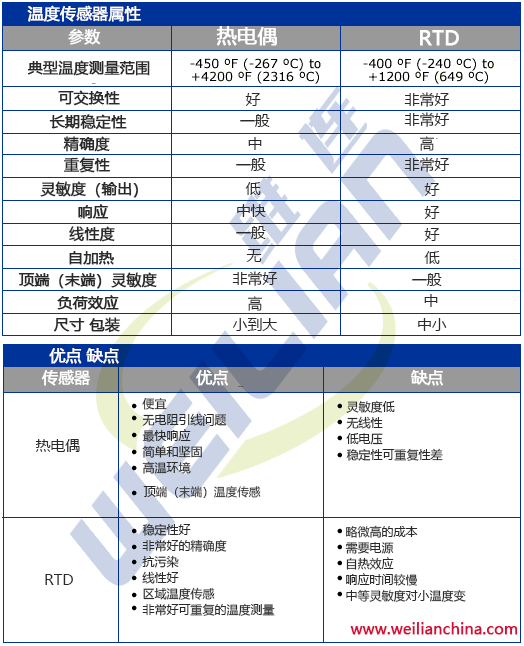
 Choose RTD temperature sensor or thermocouple temperature sensor?
Choose RTD temperature sensor or thermocouple temperature sensor?
Thermocouple (TC) and resistance temperature detector (RTD) are the most widely used temperature sensors in automation and process control. They are embedded in motors, valves, turbines, bearings and many other equipment. Most intelligent instruments, such as flow meters, pressure transmitters and level transmitters, also have an embedded temperature sensor - used to calibrate the main measured variables or for process control.
working principle
The thermocouple is connected by two wires of different metals, two ends - the reference point outside the process (cold end) and the measuring point (hot junction) at the junction. Metals react differently to temperature changes and generate electromotive force (EMF) voltages based on the temperature difference between junctions (Seebeck effect). A resistance temperature detector is based on the principle that the resistance of a metal wire increases with temperature.
In both cases, the sensor is connected to a calibrated sensor or signal conditioner to accept the input voltage or resistance, calculate the correct temperature, and output it to the automation system as a 4-20 mA, mV, or digital signal
The above is very basic, and there are professors in every instrument course. But it raises the first question to consider when selecting sensors: how to connect sensors to sensors, signal conditioners or automation systems? Such equipment and systems are electronic in nature and need to be installed in a reasonably safe location away from high temperatures.
TC must use thermocouple extension wire for wiring, which is the same as that used in TC. For example, the K-type TC uses a nickel chromium wire that is connected to a nickel aluminum nickel wire at the sensing junction. The extension wire must be of the same composition, i.e. a nickel chromium wire and a nickel aluminum wire. In general, the use of longer extenders is discouraged because they act as antennas, making measurements more susceptible to electromagnetic and radio frequency interference. Cost can also be an issue when dealing with long extenders, especially those using special materials (e.g. R-type TC). In some cases, compensation cables made of cheaper materials with EMF characteristics similar to TC can be used.
On the other hand, the maintenance RTD can be connected to a longer distance with standard cables; However, they are usually limited by problems related to self heating errors. In both cases, the extension cord must be shielded to prevent electrical noise in the equipment. Note that TC extenders are more susceptible to noise than RTD cables.
Temperature measurement environment
Temperature sensing is usually carried out in an "unfriendly" environment, such as corrosive, oxidizing or reducing atmosphere, usually accompanied by severe vibration and electrical noise. When selecting RTD or TC, the environment must be considered. If the risk of sensor failure is high due to the process environment, the use of thermal sleeves made of materials suitable for the process environment should be considered.
Vibration- Wire wound RTDs are most susceptible to vibration. In high vibration applications, wire wound RTDs may fail due to mechanical stress and should not be used. Thin film RTDs have higher resistance to vibration, but are not as good as TC, which has the highest resistance to vibration.
Electrical noise- As mentioned above, both RTD and TC extension cords are vulnerable to electrical noise. In high noise environment, the extension wire shall be sheathed, shielded, grounded and as short as possible. RTD is a better choice in high noise environment.
Harsh environment- When dealing with harsh environment, please check whether the manufacturer of RTD or TC sensor provides protection against adverse conditions. The wound RTD in the protective enclosure is very robust and is not affected by most environmental problems. To provide additional protection, RTDs may be coated with perfluoroalkoxy (PFA) polytetrafluoroethylene for use in electroplating baths, high-pressure systems, or similar applications. RTD extension cords may be protected with PVC, PFA or fiberglass insulation.
The maintenance TCs, especially those with metal shells, are much stronger than RTDs and can better handle corrosive or oxidizing environments. When using exposed TC junctions, special care must be taken in harsh environments.
TC is classified by type, i.e. E, J, K, N, T, S, R and B. Each type is suitable for a specific temperature range from - 201 ° C to 1700 ° C, and the construction of each type makes it suitable for various environments:
● Type E: applicable to vacuum, inert, mild oxidation or reduction atmosphere
● Type J: can be used, exposed or unexposed, in the absence of free oxygen
● Type K: usually requires metal or ceramic protection
● Type N: oxidation resistance in the presence of sulfur
● Type T: it can be used for oxidation or reduction atmosphere
● Type S, R, B: always use ceramic tubes, ceramic auxiliary tubes and silicon carbide or metal outer tubes for protection according to conditions
Main considerations for selecting TC or RTD
Measuring range: RTD can measure temperatures up to 1000 ° C, but it is difficult to obtain accurate measurement values from RTD at temperatures above 400 ° C. The TC can measure temperatures up to 1700 ° C. It is generally accepted that for temperatures below 850 ° C, RTDs are used to ensure accuracy; For temperatures above 850 ° C, use TC. Industrial measurements are typically 200 ° C to 400 ° C, so RTDs may be the best choice in this range.
Response time: Although both sensors can quickly respond to temperature changes, TC is faster. However, in some cases, the manufacturing process allows the production of thin-film RTDs with significantly reduced response times.
Size:Both sensors are fairly small, with a diameter of approximately 0.5 mm. If there is a problem with the space to install the sensor, contact the vendor for dimensions and installation options.
Vibration:In general, TC is less sensitive to vibration than RTD. However, in some manufacturing processes, film RTDs with higher vibration resistance than standard RTDs can be produced.
Self heating:RTD is made of very thin wire or very thin coating, which requires voltage from power supply - TC does not need power supply. Although the required power is only 1 mA to 10 mA, it will cause the platinum element in RTD to "heat up", thus affecting the accuracy of measurement. If long extension wires are used, more power may be required to overcome the resistance in the wires, thus increasing the problem of self heating.
stability:The long-term stability of RTD is very good, which means that its readings will be repeatable and stable for a long time. On the other hand, TC tends to drift. Due to the change of oxidation, corrosion and other metallurgical characteristics of the sensing element, the EMF generated by TC will change with time. TC drift is irreversible and requires some measures to detect it, such as software or testing loop resistance.
Accuracy:In general, RTD is more accurate than TC. RTD can produce accuracy of 0.1C, while TC can only be accurate to 1C.
Although it is not a technical problem, TC is much cheaper than RTD, mainly because of the lower production cost. This may be a major factor depending on the number of sensors required for a particular application.
Careful selection of the correct temperature sensing technology is essential to ensure optimum performance, reliability and cost-effectiveness.
Why choose RTD instead of thermocouple?
Better accuracy and repeatability
– RTD signals are not susceptible to noise
– Better linearity
– RTD can be "matched" with transmitter (eliminating interchangeability error)
– CJC error inherent in T/C; The lead resistance error of RTD can be eliminated
Better stability
– T/C drift is unstable and unpredictable; RTD drift is predictable
-T/C cannot be recalibrated
Greater flexibility
– No special extension cord required
– Don't be careful with the cold end
Why choose thermocouple instead of RTD?
Higher temperature applications
• Above 1100 ° F
Reduce element cost
• Same cost when considering temperature point performance requirements
Faster response time
• negligible compared to the response time of the process
Stronger
• Construction technology produces extremely robust RTDs
RTD and thermocouple comparison table
You can contact us if you have any questions about the choice of thermocouple or RTD temperature sensor. Tel./WeChat 18717811268 Huang Gong Email sales@weilianchina.com



